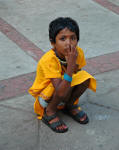Kolkata City, West Bengal, India (Related Pages: Calcutta, Durga Puja 2005, Indian Museum)
India's largest city and once the capital (1772-1912) of British India, Kolkata (formerly Calcutta) is located on the east bank of the Hooghly, a channel of the Ganges, 154 km upstream from the Bay of Bengal. Growing beyond its British colonial foundations, Kolkata assimilated strong European influences to create an amalgam culture that found early expression in the life and works of the 19th-century Bengali elite and its best known figure, Rabindranath Tagore. Kolkatans are said to possess a rare joie de vivre that manifests itself in their penchant for art and culture and a level of intellectual vitality and politica
l awareness unsurpassed in the rest of the country. No other Indian city can draw the kinds of crowds that throng to Calcutta's book fairs, art exhibitions, and concerts. There is a lively trading of polemics on walls, which has led to Kolkata being dubbed the city of posters. But Kolkata thrives amid seemingly insurmountable economic, social, and political problems. For all its vitality, a large number of its residents live in abject conditions, far removed from the rarefied cultural milieu. Many a visitor remarks on the city's air quality, physical decay, and fetid smells. In short, Kolkata remains an enigma to many Indians as well as to foreigners. It continues to puzzle newcomers and to arouse an abiding nostalgia in the minds of those who have lived there. ♣ [- Oct '05 & Oct '06]
Kalighat |
|||
Kalighat temple  |
Calcutta rickshaw  |
Street dweller (more)  |
Public bathing  |
Kalighat widow  |
Kalighat man  |
Kalighat woman  |
Kalighat man  |
Nirmal Hriday  |
Public mouthwash  |
Folded hands  |
Worth fixing?  |
|
Santoshpur & Jadavpur |
|||
Leftist posters  |
Communal ground water tap  |
Jadavpur University area  |
Bagha Jatin station  |
Bagha Jatin store  |
Waiting for the train  |
Marriage vows  |
Layout for a puja  |
A wedding household  |
A post-monsoon wedding  |
Calcutta Lake Club dinner  |
Fish curry (maacher-jhol)  |
|
Gariahat |
|||
Rickshaw  |
Roadside eatery  |
Souvenir stall  |
Open air bathing  |
Calcutta street  |
Gariahat area  |
Gariahat area  |
Calcutta tram  |
Roadside barber  |
A shrine and its architect  |
Bookstore  |
Gariahat fish market  |
Gariahat fish market (more)  |
Fruit stall  |
Flower market  |
Gariahat nursery  |
Gariahat market  |
Goodies  |
Drinking coconuts  |
Kwality Walls ice-cream  |
|
Sealdah & College St. |
|||
Sealdah station  |
College street  |
English literature bookstore  |
Sunday morning scene  |
Presidency college  |
College / MG road  |
Chariot on MG road  |
Mama Stall No--1A  |
 |
Calcutta rickshaw  |
Calcutta rickshaw  |
Calcutta rickshaw (more)  |
MG Road  |
Street dweller  |
Street dweller  |
Sunil Ganguly on a billboard  |
Side street near Sealdah  |
Round gourd  |
Street near Sealdah (more)  |
Custom cards store  |
Calcutta Tram  |
Calcutta Tram  |
Calcutta Tram  |
Calcutta Tram  |
Directing traffic  |
Jagadhatri puja spot |
Jagadhatri  |
Black Krishna (more)  |
|
Dakshineshwar Kali Temple |
|||
Boat on the Hooghly  |
 |
 |
From the river (more)  |
The Hooghly (more)  |
Guavas  |
Snack joint  |
Bathing couple  |
|
Belur Math |
|||
From the river  |
Main building (more)  |
Side view (entrance gate)  |
Large pot  |
Widow at Belur Math  |
Squatting Girl  |
Bengali pilgrim  |
Announcing a fair  |
|
Miscellaneous |
|||
Victoria Memorial  |
Howrah bridge  |
Piggybank vendors, Howrah  |
Kathi roll off Park St.  |
Designed in collaboration with Vitalect, Inc. All rights reserved. |









